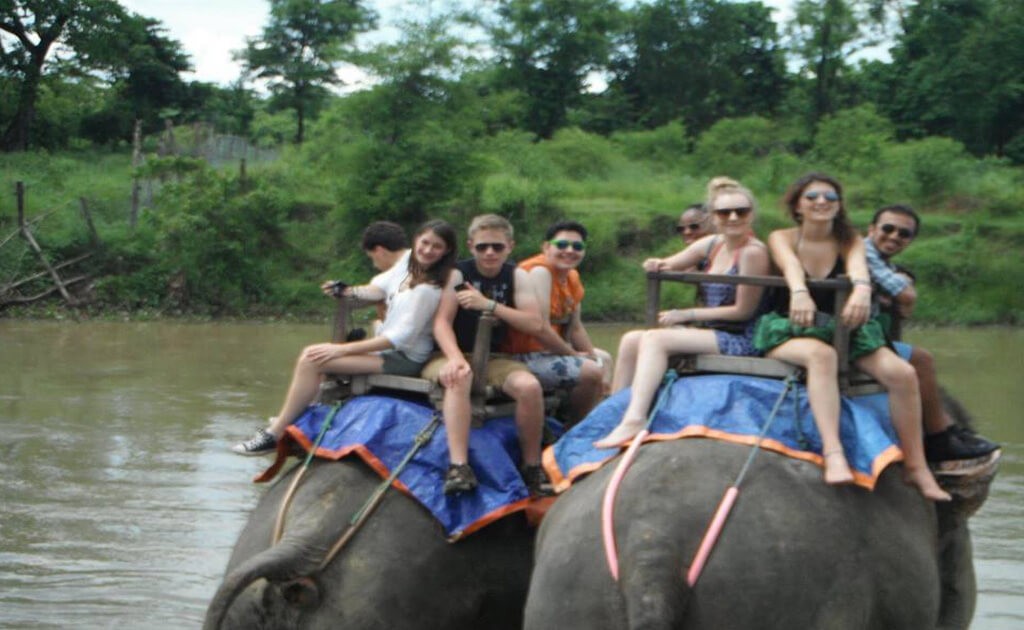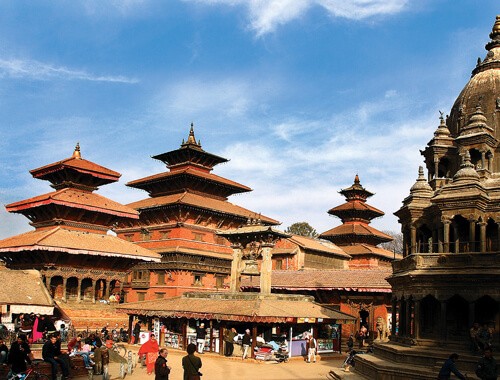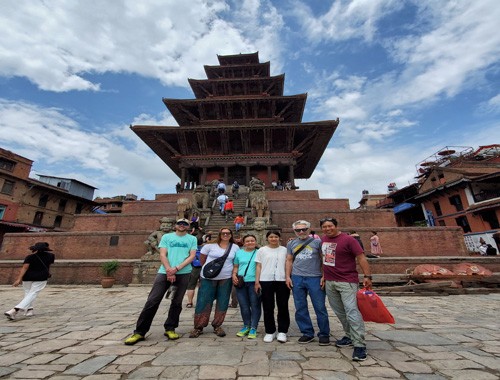Kathmandu Chitwan Pokhara Tour
Kathmandu, Chitwan, Pokhara Tour is an excellent tour to visit and see ancient heritage sites in Nepal. It commences from Kathmandu to visit the ancient heritage sites there, and the tour then heads to Chitwan National Park to carry out the activities of elephant safari and jungle walking, etc. The tour then heads to the beautiful and peaceful city of Pokhara, which is situated beside the beautiful, large Fewa Lake. It will give you great joy and pleasure for your great holiday. The Kathmandu Chitwan Pokhara Tour is the best in Nepal. During a week can visit so beautiful jungle safari in Chitwan, and the nice city of Pokhara will be a great tour
9 Days Tour Itinerary
Day 1: Arrival at Kathmandu airport (1300m): Arrive at Tribhuvan International Airport in Kathmandu, and a representative of Unique Nepal Adventure Trek will welcome and transfer you to your selected hotel by private vehicle and give an hour’s brief about the tour.
Sightseeing in Kathmandu Valley to the World Heritage Sites – Durbar Square, Swayambhunath, Boudhanath, and Pashupatinath:
Day 2: Starts early morning (8 am) after having breakfast your tour will start with a private vehicle and with an expert tour guide who is a government trained license holder and well-informed. He will explain Nepal’s history and culture as well as its natural beauty.
Kathmandu Durbar Square: The Kathmandu Valley is indeed a unique type of valley, in an exotic setting. Twenty-five centuries back, it stood as a titanic lake. It is almost surrounded by a tier of green mountain walls above, where, to the north, tower the mighty snow–capped peaks during the winter. It consists of four major cities carrying great historical, artistic, and cultural interest. They include Kathmandu, Patan, Bhadgaon, and Kirtipur. Ironically speaking, Kathmandu Valley was an empire owning four petty kingdoms until 1769 AD. The four kingdoms of Kantipur, Lalitpur, Bhaktapur, and Kirtipur have today appeared as independent modern cities. The Valle,y with an approximate population of a million and a half, covers an area of 218 square miles and is situated at an altitude of 1300m above sea level as part of the Shangri-La. Kathmandu (Kantipur)-the Capital.
Durbar in Nepali means “Palace,” and in Patan and Bhaktapur as well and Kathmandu, there are durbar squares in front of their old palaces. The king no longer lives in the old royal palace in Kathmandu. Actually, Durbar Square is the “Heart” historic seat of Royalty. The durbar square contains old temples and palaces such as the Basantapur tower, Kumari (The living goddess), Kastamandap (House of wood), Garuda, Shiva temple, Sweta and Black Bhairab, Taleju Temple, old royal palace, Hanuman statue (God of monkeys), etc.
Swayambhunath: This is believed to be 25 centuries old and stands as one of the world’s oldest Buddhist Chaityas. The Great Stupa of Swayambhunath is the wonder that was Nepal, the glory that was Nepal. It is indeed listed as a World Heritage Site of Culture to prove that it serves as the nerve centre of faithful worship for all the devout Buddhists of the universe. Swayambhunath embraces the authentic philosophy of Bajrayan in particular and honours Lord Buddha. It is dedicated to the self-originating flame God. The Stupa, which forms the silent structure, is well composed of a solid hemisphere of terra-cotta bricks and soil supporting a cornice of copper and gilt. Painted on the four-sided base of the spire are the all-seeing eyes of Lord Buddha, keeping an eternal watch on the Valley, distinguishing between vice and virtue. It is some two miles west of Kathmandu City proper, across the holy Bishnumati River. Situated on the top of a hillock, it is about 500 feet above the level of the Valley. The whole hill is a mosaic of small Chaityas and pagoda temples possessing great dignity plus beauty. There also exist six big Buddhist monasteries in all-five Mahayan (Lamaist) and one Hinayana (Theravada). On the hill is located another important Buddhist shrine; it is called Manjushree. This compassionate Chinese Buddha is the God of Knowledge.
Boudhanath: This is declared to stand as the largest Buddhist shrine of South Asia. The ancient colossal chhorten was built in the 6th century AD by King Man Deb belonging to the Lichhabi dynasty. It rests on a series of three terraces and from the bird’s eye view it takes the relevant shape of a lotus flower which indeed remains a very holy object for the devout Buddhists of the entire world. The chhorten is surrounded by a circular market which forms a part of Tibet Town. In this case also the four pairs of the Buddha’s eyes give a vivid flash to the four cardinal directions, meaning to keep a diligent watch over the people and their commitments all day all night. The chhorten embraces the authentic philosophy of Mahayan the faith of which is known as Lamaism in Sikkim, Ladakh, Bhutan and Tibet. It also proves a World Heritage Site.
Pashupatinath: It is a pagoda-style Hindu temple with gilt roofing’s and richly carved silver doors dedicated to Lord Shiva and is situated at the bank of the holy Bagmati River. One of the most sacred temples in the entire Hindu world, Pashupatinath Temple is the nerve center of pilgrimage on the day of Shivaratri. The minute religious town itself which houses the great temple is known as Debpatan and is situated 5 kilometers east of the capital city. Only Hindus are permitted to enter the main courtyard of the temple. Tourists can view the temple from the eastern side of the Bagmati River. Guheshwori Temple: On a forested knoll further behind Pashupatinath Temple to the eastern direction and also by the side of the bending or winding Bagmati River appears the gracious temple of Guheshwori sometimes known as Akash Yogini. It is another famous spot of Hindu pilgrimage. It houses the shrine of Goddess Parbati who is Lord Shiva’s spouse. In this case also, only Hindus are authorized to enter the premises.
Day 3: Sightseeing in Bhaktapur Durbar Square and Patan Durbar Square:
These are historical ancient places and it will need more than a couple of hours to visit each place. Detailed explanation will be given about these historical monuments.
Bhaktapur Durbar Square: Bhaktapur Durbar Square is a conglomeration of pagoda and shikhara – style temples grouped around a fifty-five-window palace of brick and wood. The square is one of the most charming as it highlights the ancient of the kings perched on top of stone monoliths, the guardian deities looking out from their sanctuaries, the wood carvings in very place – struts, lintels, tympanums, gateways and windows – all seem to form a well-orchestrated symphony.
The main items of interest in the Durbar Square are: -
*The Lion Gate:
Dating as far back as AD 1696, this gate is guarded on either side by huge statues of lions. Alongside, there are two stone images of (the dreadful aspect of Shiva) and Ugrachandi (the consort of Shiva in her fearful manifestation).
* The Golden Gate:
The Golden Gate is said to be the most beautiful and richly moulded specimen of its kind in the entire world. The door is surmounted by a figure of the goddess Kali and Garuda (the mythical man – bird) and attended by two heavenly nymphs. It is embellished with mythical creatures of marvelous intricacy. In the words of Percy Brown, an eminent English art critic and historian, the Golden Gate is the loveliest piece of art in the Kingdom: it is placed like a jewel, flashing innumerable facets in the handsome setting of its surroundings. The gate was erected by King Ranjit Mala and is the entrance of the main courtyard of the palaces of Fifty – Five windows.
The Palace of Fifty – Five Windows: This magnificent palace was built during the reign of King Yakshay Malla in AD 1427 and was subsequently remodeled by King Bhupatindra Malla in the seventeenth century. Among the brick walls with their gracious setting and sculptural design, is a balcony with Fifty-Five Windows, considered a unique masterpiece of Woodcarving.
The Art Gallery: The Art Gallery contains ancient paintings belonging to the Hindu and Buddhist traditions of various periods and descriptions. This gallery is open every day except Tuesday.
The Statue of King Bhupatindra Malla: This statue shows King Bhupatindra Malla in the act of worship is set on a column facing the palace. This is considered the most magnificent statue among the many statues in the squares.
Patan Durbar Square:
Patan Durbar Square, like its counterpart in Kathmandu, is an enchanting mélange of palace buildings, artistic courtyards and graceful pagoda temples. Listed as a World Heritage Site, the former royal palace complex is the center of Paten’s religious and social life, and houses a museum containing an array of bronze statues and religious objects. One remarkable monument here is a 17th-century temple dedicated to the Hindu god Krishna, built entirely of stone.
The main attractions in Patan are: -
Golden Temple
Kumbheshwar
Krishna Mandir
Jagat Narayan
Mahaboudha
Asoka Stupa
Machchhendranath Temple
The Tibetan Camp
Day 4: Kathmandu to Chitwan by vehicle (5hrs):-
Early in the morning start from Kathmandu and arrive in Chitwan around lunch time.
Program schedule:
1:00 pm Arrive & have lunch
3:30 pm Elephant Safari / Jungle Walk / Mature Walk with Boat Ride
8:00 pm Dinner
Days 5: Full day program in Chitwan:
5:30 am Wakeup call followed by tea/coffee
6:00 am Bird watching / Elephant Safari / Jungle walk
8:00 am Breakfast
9:30 am Crocodile walk. A 45 minutes’ walk-through grass land and forest upstream of the Narayani or Rapti rivers. Board boats to observe the wild life whilst floating back to camp
1:00 pm Lunch
3:30 pm Elephant bathing / Elephant Safari /Jungle Walk / Visit Observation Tower / Nature Walk with Boat Ride
8:00 pm Dinner
Day 6: Drive to Pokhara (5 hrs)
Chitwan to Pokhara by vehicle (5hrs) and do some sightseeing and stay at a hotel in Pokhara near the lake side.
Day 7: Sightseeing in Pokhara:
Pokhara
Millions of people travel thousands of miles in search of heaven or paradise on earth fully unaware of the existence of a corner of real paradise. Pokhara valley is situated at an altitude of 827 meters from sea level. This is one of the picturesque spots of Nepal. It’s lovely lakes and mountains enhance the beauty of the valley. Pokhara is situated 200 kilometres west of Kathmandu. It is linked by air and by road from Kathmandu and the Indian border Sunauli. Pokhara offers magnificent views of Dhaulagiri, Fishtail, Manaslu, five peaks of Annapurna and others. This is one of the few places in the world to provide such a dramatic view in a sub-tropical setting. The nearest snow-capped mountain, Fishtail is less than 30 kilometers from Pokhara. Pokhara’s numerous lakes offer fishing, boating and swimming.
Sarangkot
Early morning start to view the sunrise. You can see the brilliant Annapurna Mountain range, Dhaulagiri Range, Manaslu Range and many more mountain views then back to the hotel and have breakfast and sightseeing for the rest of the day.
Barahi Temple
The Barahi Temple is the most important monument in Pokhara. Built almost in the center of Fewa Lake, this two-storied pagoda is dedicated to the boar manifestation of Ajima, the protester deity representing the female force, Shakti.
World Peace Pagoda
This pagoda is situated on the top of a hill on the southern shore of Fewa Lake. It has four images of Buddha facing in all directions. The pagoda is an impressive sight and its hilltop location commands great views. It is a great vantage point, which offers spectacular views of the Annapurna range and Pokhara city.
Gupteshwor Cave Just opposite of Devi’s fall, on the other side of the road, there is Gupteshwor Cave. This cave is popular for the different natural forms made from limestone deposits.
Bindhyabasini Temple
This is one of the oldest temples in Pokhara. Legend says that when Pokhara was a part of Kaski Kingdom, the main deity of the temple, Goddess Durga, was brought from India. Apart from the peace and tranquility that can be felt in this region, the premises of the temple offers a good view of the Himalaya on a clear day. The temple is in the area of the Bazaar; hence, a journey of the old bazaar can be combined with a visit to the temple.
Caves and Waterfalls in Pokhara
Pokhara is famous for limestone caves such as Mahendra Cave, Gupteshwar Mahadev and others. Davis Falls is the most famous water fall in Pokhara, which comes to its gushing best just before disappearing underground.
Lakes and Rivers in Pokhara
Pokhara are also known as Lake City. There are seven famous lakes – Phewa or Fewa, Begnas and Rupa being the most well-known ones. The glacial river Seti, flows right through the heart of the Pokhara valley and goes completely underground at certain intervals.
Day 8: Pokhara to Kathmandu:
Pokhara to Kathmandu by bus (6-7 hrs.) by flight (45 minutes) and stay at your selected hotel in Kathmandu.
Day 9: Departure to the International airport:
A representative of Unique Nepal Adventure Trek will drop you off at Tribhuvan International Airport by private vehicle.





